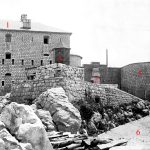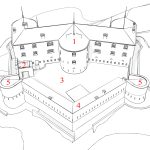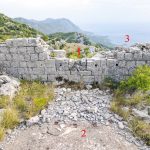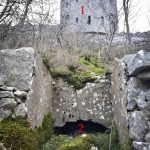Around 1841, after the demarcation between the Austrian Empire and Montenegro, the Austrian Empire decided to better fortify the newly defined border with the Kingdom of Montenegro. The chain of forts on tactical locations in this area formed the extended defense area of Budva. One of the most important forts on this line was Fort Kosmač, built in 1858 by the Austrian Empire. The construction was done within a year mostly out of local stone with the help of local people. It was a so called mountain fortress, intended to control or block the pass at this important tactical location at the time. The design was very advanced and modern for its time, even though the revolution of the fortress design came within two decades, it preformed its intended roll well.
The design was based on a type called “Cannon tower” adapted for its purpose and location consisting of the fortified three story barracks oriented towards the border and the fortified courtyard towards the steep cliff and the sea on the inside of the territory. It was designed to be a permanent fortified position which meant it had all the necessary elements to sustain and protect its crew for months in case it came under siege, exactly what happened during the Bokelian Uprising in 1869.
The entrance consisted of a gatehouse with a drawbridge leading into the courtyard. Inside there were mostly utility rooms along the outer wall as well as the access to both caponiers, one on the northern and one on the southern side, intended to flank the enemy that came into the ditch circling the fortress full of wire fences and obstacles. The most important element in the courtyard was the rain water collecting system with the main water reservoir located in the middle of the courtyard. The access to the fortified barracks was inside the courtyard on the northern side. The entrance into the barracks was also protected with a drawbridge over a half-circular ditch inside a courtyard and the metal double winged door. The fortified barracks housed the most important elements of the fort, such as the crew accommodation, kitchen, provision storage, toilets, hospital quarters, secondary water reservoir and the ammunition storage located in the western wing between the stairway which led to the “cannon terrace” on top, covered with a slanted roof. The design made possible for crew to defend the fort in layers up to the inside of the barracks if the attacker managed to break through the main gate, which could by the defenders some more time before they are relived. The fort was equipped with six lighting rods 4m high, due to the characteristic weather of the location which gave the fort the iconic silhouette.
During its service, the fort was modernized several times as the technologies advanced but its design limited its ability to effectively withstand as a stronghold against the weapons used in the First World War. When the war started the Empire realized it cannot form a functional defensive line on this location, so it decided to abandon and demolish all the forts on the extended defense area of Budva, including the Fort Kosmač which was rigged with explosives and set on fire after the imperial troupes abandoned it on the August 18th, 1914.
Since 1964 the fort is an enlisted cultural monument.
(guest writer: Ivan Vratnica)
Deutsche Zusammenfassung:
In den Jahren nach 1841 beschloss das Kaiserreich Österreich seine Grenze zum Fürstentum Montenegro zu befestigen. Aus diesem Grund entstand in den folgenden Jahren, an strategisch bedeutsamen Punkten, eine Kette von Befestigungsanlagen. Das Bedeutendste der insgesamt fünf Forts war das im Jahr 1858 nordöstlich der Stadt Budva erbaute Fort Kosmač. Es sollte den in der Nähe befindlichen Pass und somit die Kommunikationslinie Budva-Cetinje kontrollieren, sowie den unmittelbaren Ortsbesitz gewährleisten.
In konzeptioneller Hinsicht entspricht Kosmač einem „Kanonenturm“, der dem Zweck und Standort entsprechend angepasst wurde. Zentrales Element ist eine dreigeschossige, kasemattierte Kaserne mit Front in Richtung der Grenze. Kehlseitig ergänzte ein ausgedehnter, befestigter Hof die Anlage. Entlang der Eskarpe lagen das Torhaus samt Zugbrücke, Lagerräume, Stallungen, sowie zwei Kaponnieren, die die Kehlseite und die Flanken bestreichen konnten. Von großer Bedeutung war die Regenwassersammelanlage in der Mitte des Hofes. Der Zugang vom Hof in die kasemattierte Kaserne wurde ebenfalls durch eine Zugbrücke gesichert. Im Gebäude befanden sich schließlich die Offiziers- und Mannschaftsunterkünfte, Küche, Proviantlager, Toiletten, Krankenunterkünfte, eine weitere Zisterne und das Munitionslager. Frontseite und Flanken verfügten über Gewehr- und Geschützscharten, Hauptaufstellungsort der Artillerie war allerdings das Verdeck. Im Ernstfall waren dementsprechend das Dach abzudecken und der hölzerne Dachstuhl niederzulegen. Aufgrund der exponierten Lage waren auf dem First insgesamt sechs 4 m hohe Blitzfangstangen montiert.
In Entsprechung eines permanenten fortifikatorischen Werks verfügte Kosmač über alle notwendigen Einrichtungen, um für mehrere Wochen autark bestehen zu können. Der Fall einer längeren Zernierung trat bereits 1869/70, im Zuge des Aufstands in der Bocche di Cattaro, erstmals ein.
In den annähernd 60 Jahren als aktives fortifikatorisches Objekt wurde Kosmač mehrfach modernisiert, war aber bereits gegen Ende des 19. Jahrhunderts als veraltet anzusehen. Hinzu kam, dass die benachbarten Forts Anfang der 1880er-Jahre aufgegeben und geschleift wurden.
Aufgrund der isolierten Lage und der Unmöglichkeit den südlichsten Teil Dalmatiens verteidigen zu können, wurde die Sperre Kosmač am Beginn des Ersten Weltkriegs aufgelassen. Beim Abzug der k.u.k. Truppen am 18. August 1914 wurde Fort Kosmač in Brand gesteckt sowie Teile der Eskarpe bzw. der Flankierungsanlagen gesprengt.
Seit 1964 steht das ehemalige Fort unter Denkmalschutz.
(Gastautor: Ivan Vratnica)
- 1) Erdgeschoß / lower floor, 2) Obergeschoß / upper floor, 3) Verdeck zugleich Geschützplattform / roof top with gun platform, 4) Treppenturm / staircase
- 1) Erdgeschoß / lower floor, 2) Obergeschoß (linke Flanke) / upper floor (left side flank), 3) Zugang zum Stiegenhaus / stair case acess
- 1) Blick auf die Frontseite / front side view, 2) ehemaliges Werkstor samt Eingangszwinger / former entrance (gate with keep), 3) Reitweg in Richtung Fort Spiridione / road to former Spiridione fort
- 1) linke Flanke / left hand flank, 2) Werkstor / entrance gate, 3) Schilderhaus | Wachposten / guard house, 4) Maschikuli aus Stahl im / machicolation built from steel at the, 5) linken Koffer / left flank caponier 6) Reitweg nach Brajići / road to Brajići
- 1) kasemattiertes, verteidigungsfähiges Objekt mit abwerfbarem Dach / removable roof on casematted, defendable object, 2) ehemaliges Werkstor samt Eingangszwinger / former entrance (gate with keep), 4) Eingangszwinger / entrance keep 5) Koffer / caponier 6) Reitweg in Richtung Fort Spiridione / road to former Spiridione fort 7) Graben / ditch
- 1) kasemattiertes, verteidigungsfähiges Objekt mit abwerfbarem Dach / removable roof on casematted, defendable object, 2) ehemaliges Werkstor samt Eingangszwinger / former entrance (gate with keep), 3) Hof / courtyard 4) Kehlmauer mit Stall und Magazinen / stable and magazines along gorge wall 5) Koffer / caponier 6) Reitweg in Richtung Fort Spiridione / road to former Spiridione fort
- 1) kasemattiertes, verteidigungsfähiges Objekt mit abwerfbarem Dach / removable roof on casematted, defendable object, 2) ehemaliges Werkstor samt Eingangszwinger / former entrance (gate with keep), 3) Hof / courtyard 4) Stall und Magazine / stables and magazines 5) Koffer / caponier 6) Reitweg in Richtung Fort Spiridione / road to former Spiridione fort
- 1) kasemattiertes, verteidigungsfähiges Objekt mit abwerfbarem Dach / removable roof on casematted, defendable object, 2) ehemaliges Werkstor samt Eingangszwinger / former entrance (gate with keep), 3) Hof / courtyard 4) Stall und Magazine / stables and magazines 5) Koffer / caponier 6) Reitweg in Richtung Fort Spiridione / road to former Spiridione fort
- 1) vormalige Position einer Geschützscharte / former gun embrasure 2) Drehkranz für 9cm M4 / slewing ring rail for a 90mm cannon Mark 1904 3) Sveti Stefan
- 1) Fort Kosmac 2) Reitweg nach Brajići / road to Brajići
- 1) linker Schulterpunkt / left-side shoulder caponier 2) Überlauf der Senkgrube / dirty sewer
- 1) Untergeschoß / lower floor 2) Obergeschoß / upper floor















